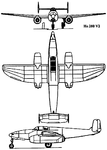drgondog
Major
The temperature effect is dominant at constant pressure. So for example the s/l thrust of an turbine engine decreases noticeably at higher ambient temperature, important everyday effect for takeoff.
But, when increasing altitude you're decreasing air density a lot and thus mass flow, so the max thrust declines. The drag on the airplane is also tending to decline with altitude, but the combination of those offsetting effects was that early jets had flatter characteristics of speed v altitude than props usually did and some jets did max out at s/l. A slightly later plane more or less comparable to the F-80C is the F9F-2: this link shows its complete speed/altitude curves, it's either max at s/l or almost completely flat depending on configuration, see pg 6.
http://www.history.navy.mil/branches/hist-ac/f9f.pdf
This tendency increased as fighter performance increased and planes got closer to the Mach drag rise in level flight. The lower the altitude the lower the Mach for a given speed so the drag rise is delayed. So, for example the F-86 and MiG-15 both maxed out at s/l.
This changed for supersonic afterburning fighters because the turbine inlet temp no longer limited mass flow, the afterburner did, plus drag characteristics change in supersonic flight. Their max TAS often occurred as high as the tropopause, where air temp stops falling (ca. 50k ft). I don't know the speed/altitude characteristic of plane like the F-22 which can well exceed M1 at high altitude w/o afterburner, but that's getting pretty far OT.
Another example back in WWII was the Meteor I. It didn't max at s/l but the difference in max speed w/ altitude was smaller than for props, so it was faster than most prop fighters at low altitude, but slower the best props at medium altitude. Hence its combat niche as V1 interceptor at low altitude.
Joe
You're right Joe - I should dragged out the propulsion books rather than rely on a memory 40 years out of current

